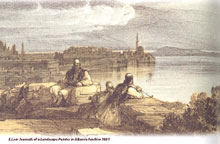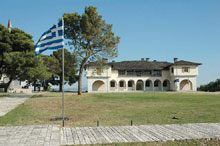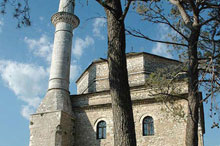 |
| The castle of Ioannina and the Islet in the background
(Engraving, 1851) |
Ioannina can trace its roots back to the 6th c. AD, as an important town
on the border of the Byzantine Empire. During that period the rocky promontory
of Ioannina was enclosed by walls and the south-eastern hill (later known
as Itch Kale) was inhabited. The area remained under Byzantine rule and
only in 1082 did the Normans (Bohemund I) occupy the city for a few months.
Following the Fourth Crusade (1204), Ioannina was incorporated in the Despotate
of Epirus (Michael I Angelus Comnenus Ducas). In 1210 the Metropolitan
Church of the Taxiarches was built (at Itch Kale). In 1292 the Philanthropinon
School was founded on the Isle of lake Pamvotis - the lake which bathed
the foot of the city walls -, rendering Ioannina an educational centre
of great importance.
The city rose in power and in 1318 the Ecumenical
Patriarchate promoted it to a metropolis, whereas in 1367 it was granted
self-governance. The tower of Thomas Preljubovic in the castle (constructed
from 1367 to 1384) highlights the monumental form that the city had acquired.
Albanian tribes raided the city in 1379, but were forced to retreat. The
gradual onward march of the Turks into the Balkans and the internal crisis
of the Despotate of Epirus led to the subordination of Ioannina to the
sphere of influence of Carlo I Tocco (Italian ruler of Cephalonia and Lefkada),
who became a despot in 1411. However, on 9 October 1430 the city was voluntarily
handed over to the Ottomans. The conquest lasted 483 years. Sinan Pasha
granted the people of Ioannina privileges to settle and trade freely. However,
the metropolitan church of the Taxiarches was converted to a mosque (Fethiye
Tzami). At the same time, the construction of the namesake monastery in
1434 on the edge of Mount Mitsikeli and on the shores of lake by the Muslim
Durahan reveals the spirit of conciliation and peaceful cohabitation between
the Turks and the Greeks. However, this situation changed after the failed
attempt of Dionysios Philosophos, the bishop who became the leader of discontented
peasants and invaded Ioannina without however managing to deal a serious
blow to the Turkish rulers.
From then on the city's Christians were deprived
of their privileges and were expelled from the castle, while 18 churches
and monasteries were demolished. The Aslan Mosque was built in 1618 on
the former location of the church of Agios Ioannis Prodromos (Saint John
the Baptist), so that the mosques overlooked the area of the castle. Despite
the blow that they had received, the inhabitants soon regained their financial
and intellectual vitality. In 1648 the School of Epiphanios Igoumenos was
founded, which was followed by the Gionma School (1672 - 1800), the Maroutsi
School (1742 - 1749) and the Kaplaneios School (1805 - 1820).
Ioannina functioned as the centre for the ten schools that were founded
in the wider area of Epirus. These schools were supported by emigrants
from Ioannina and Epirus, who had settled mainly in Venice. From the mid-17th
century, trade with the Adriatic ports was ever increasing, and the fact
that the three eminent publishers of Greek books during the time of the
Turkish occupation, namely Glykis (1670 - 1854), Saros (1681 - 1707) and
Theodosiou (1755 - 1824), were from Epirus can be viewed as indicative
of the region's general growth during that period. The majority of the
teachers of the pre-revolutionary period taught n Ioannina: Georgios Sougdouris,
Vissarion Makris, Parthenios Katzioulis, Mihail Mitrou in the 17th c.,
Balanos Vasilopoulos, Konstantinos Vasilopoulos, Evgenios Voulgaris, Methodios
Anthrakitis in the 18th c., and Athanasios Psallidas, Ioannis Vilaras,
etc. in the 19th c. The 18th century was an auspicious time for the city
and the progress that was achieved was exploited by Ali Pasha, when he
took over the governance in 1788. His economic and military power rendered
the city a crossroad in the Balkans and foreign travellers marvelled at
the court of Ali Pasha. However, he himself led the city to absolute destruction,
since only one residence (today known as the "Despot's manor house")
survived the fire of 25 August 1820. However, the final formation of the
city walls (1815), as well as the arrangement of the settlement within
the walls, is attributed to him.
Many legends originate from Ali Pasha's personality, yet the drowning of
Kyra Frosini and the hanging of Katsandonis (1809) are real events. Following
this period, the people of Ioannina regained strength and in 1828 the first
Zosimaia Teachers School was founded, in 1833 the Metropolitan Church of
Agios Athanasios opened and in 1867 the Seminary opened on the Isle. The
hanging of Georgios the Neomartyr (1838) did not eliminate the harmony
between the Muslims and the Christians. The Turks of Ioannina accepted
Hellenic culture, in the same way the local Jewish element (whose presence
in the region dates back to the early Byzantine period) was firmly bound
to the area. In 1870 the seraglios of Itch Kale and part of the city, which
as of then started to take on a different form due to the stone buildings,
burned down. On 21 February 1913 the Greek army entered the city.
In the early 20th century the region was in turmoil twice; in 1917 with
the Italian occupation and in 1944 (25th of March) when the Germans sent
1850 Jews to Auschwitz. After the Ottoman era came to an end, the city's
intellectual life developed rapidly. The Teacher Training College, which
later developed into the Zosimaia Academy, was founded (1913), whereas
at the same time a Kindergarten Teacher Training College and later an Assistant
Engineering School opened. Even before the liberation from Ottoman rule
newspapers were printed, whereas during the interwar period, various types
of magazines were published, of which the Epirotika Chronicles continue
to survive till today. The post-war period witnessed an increase in the
number of intellectual societies, the greatest one being the Society for
Epirot Studies, which introduced the idea of a Folklore Museum and created
a specialised Epirot library. Today, Ioannina is called on to play a dominant
role in the Adriatic-Egnatia Odos axis, since, in terms of population (110,000
inhabitants of the basin), it constitutes the metropolis of Epirus as well
as the economic and intellectual centre of northwestern Greece. [Courtecy
of G. Ploumidis, Professor of Modern History, University of Ioannina.]
The castle of Ioannina
From the 6th century that the castle was built it remained the hub of all
activities in the city, changing many rulers, mainly Franks, Serbs and
Ottomans; the latter conquered it in 1430. According to each ruler’s will,
the castle was annexed or changed to a great degree. It took its current
shape, however, during the rule of Ali Pasha at the end of the 18th century.
The core-buildings of the Castle lie on its northern side, where the mosque
of Aslan Pasha was erected, one of the most beautiful mosques on the whole
of Greece. The centre of administration during the rule of Ali Pasha was
transferred to the southern side of the castle (Itch Kale); there Ali Pasha
built his palace, which after his death was destroyed. Cultural events
take place today within the castle.
 |
 |
| The first core-building of the castle
with the mosque of Aslan Pasha and the Theological school. |
| |
 |
 |
| The Byzantine Museum of Ioannina on the northern
side of the castle... |
...and Fethiye or Victory Mosque. |
| |
 |
 |
| Halls and exhibits of the Byzantine
Museum of Ioannina. |
| |